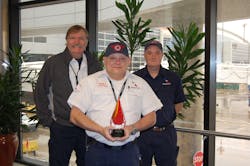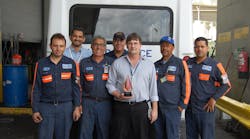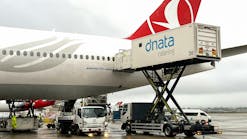Ricardo Carazo: 2018 Team Leader of the Year
Ricardo Carazo has always loved airplanes, which is why he enjoys living just five minutes away from Dallas/Fort Worth (DFW) International Airport, where he works as a crew chief for American Airlines.
He also says he loves the smell of jet fuel, which gets his adrenaline pumping and prepares him for another day of servicing aircraft at Gate D40.
Perhaps most importantly, Carazo cares deeply for the members of his crew – Glenn Fox, Bill Delinger, Shelly Trowbridge, Howard Vazquez, Chris Edwards, Sterling Scott and Dwain Pickney. He works side-by-side with his team members, and as a group, they have achieved zero delays.
Because of his accommodating managerial style and impeccable professional record, he has been named the Ground Support Worldwide 2018 Team Leader of the Year.
Building Experience
Carazo has been a crew chief for 19 of the 28 years he has worked for American Airlines.
He started with the airline in 1990 as a fleet service clerk at San Juan International (SJU) Airport in Puerto Rico.
As his career advanced, he became qualified as an acting crew chief, filling in when needed to cover for others on vacation. Then, he became a full crew chief in 1999. In 2008, he was transferred to DFW, where he has worked since.
While serving as a fleet service clerk, Carazo said he desired to take on more.
“I wanted the responsibility, the challenge,” he says. “So in ’99, that’s when I decided I was going to put in a bid for the position.”
Carazo’s passion for aviation started at a young age. Carazo spent a lot of time with his father, a pilot in the Air Force, watching planes take off and land at the airport and learning more about them. His interest in airplanes continued to rise. So when he secured work for an airline, he says it was “dream come true.”
“Every time I would go to the airport and see them take off and land, I was super excited. I always said, I wanted to be in there with those airplanes,” Carazo recalls.
His aviation knowledge hasn’t stopped expanding thanks to decades of experience and ongoing training.
“We are training non-stop, year-round, day-in and day-out,” Carazo says.
Through American Airlines, alone, Carazo has attended the Crew Chief Workshop as well as the Leadership Summit for Crew Chiefs.
At the Leadership Summit for Crew Chiefs, recently held at company headquarters, he and his colleagues received information regarding tools that they’ll be receiving in the near future to make their jobs more productive.
He says all training is critical to ensure his team’s work is completed properly and safely.
“We deal with restricted articles, animals, mail, freight and bags. This has to be properly segregated and loaded in different compartments for the safety of our traveling animals in our planes’ bellies, and of course the safety of our passengers and co-workers on that plane,” he says.
Ramp Responsibilities
Carazo manages the second shift crew, which is comprised of six crew members. His crew is stationed at Gate D40 at DFW, where there has never been a delay caused by his team of ground handlers.
“We as a crew have accomplished zero delays, which is hard in this fast-paced operation,” he says, adding it’s a feat his team takes tremendous pride in.
“It’s always been in and out proficiently, and planes are ready to depart 15-20 minutes before departure when they’re still boarding passengers,” Carazo continues. “In my whole career, I’ve never had a delay.”
Carazo’s former crew chief in San Juan once offered an important piece of advice. He told Carazo to learn to see in front of him, behind him and to the sides simultaneously to avoid dangerous situations.
“At the end of each day, we need to go back to our families,” he says. “There is no place for failure.”
While he refers to his fleet service clerks as “the backbone” of the operation because they “do all the heavy lifting,” it is Carazo’s job to make sure the team is adequately prepared with the correct tools and equipment. He also ensures they are conducting their work safely.
“Just plan for the worst, and expect the better,” Carazo says. “I go out with enough time, so if equipment breaks down or anything does happen, we still have spare time to wiggle around and get those planes out on time. That’s what we want.”
For example, if Carazo and his crew know bad weather is coming, they begin the turnaround process sooner to ensure bags don’t get wet and to make sure mail or even animals are stowed safely.
“We’re not scared of water. We’ll do whatever it takes to get those planes in and out,” he says.
The crew consists of two “belly guys” who work inside the aircraft, loading and unloading, in addition to serving as wing walkers; two drivers, who separate bags as they come down from the belly and transfer them to connecting gates; a “local man” that is in charge of delivering all local bags to the local baggage system belt, in addition to keeping the gate organized for the day’s operations and pushing out aircraft for on-time departures; and a sixth man who assists everyone at the gate, handling tasks from servicing water to delivering bags.
The ability to multitask is extremely important.
“We are seven of many moving parts of this finely tuned airline,” Carazo explains.
Personally, when the plane comes into the gate, the first thing Carazo does is check for damages that may have occurred during flight or by any equipment or personnel at another station. If there are damages, he reports them, so they can be properly repaired.
He trusts his team to perform their duties, but Carazo is also willing to crawl in the belly to load or unload bags and service the aircraft’s water in order to keep the process on time.
“I get in there with them and I get dirty,” he says. “My white shirt doesn’t mean that I’m going to go home clean. It means that I probably go home with my shirt all stained like they do.”
However, Carazo’s willingness to help does not mean he micromanages his crew.
“I’m not on top of them telling them what to do,” he notes. “We’re all adults, we know we’re all professionals.”
Then, during the loading process, he is responsible for ensuring the plane is loaded properly. He pays close attention to weight and balance – the most important skill crew chiefs learn, according to Carazo.
“Not all aircraft types are the same when it comes to loading. Some are tail heavy, others are nose heavy – meaning that we need to know how to load each type of airplane,” he explains.
“Every time a plane comes in, I go to the computer and I pull up the paperwork,” Carazo continues, noting he receives pertinent weight information from the airline’s load agents. “If we don’t do it properly, then it’s going to become a delay. We probably have to reopen the bellies, move things around and create a lot of inconvenience for our passengers.
“So we’re always thinking a step ahead.”
During the loading process, he is also making sure his crew is working safely.
“When I’m loading, I’m always facing towards the traffic. That way, if somebody’s coming in too fast or out of control, which has happened before, at least I can give them a heads up to move out of the way, so they don’t get hurt,” he explains.
Carazo says his team unloads 500-10,000 pounds of bags, mail and freight, and reloads the same airplane with another 3,000-10,000 pounds of the same.
“Depending on the destination and narrow-body airplane type, this is done in 40 to 50 minutes,” he says, adding his crew is required to be ready 10 minutes before arrival and have the plane fully loaded with the cargo doors closed and secure 10 minutes before departure in order to ensure an on-time pushback. “We work around four to five planes in an eight-hour shift.”
He says every day on the ramp is different, and they regularly encounter unique scenarios.
Leading by Example
With so much work to accomplish during their shift, Carazo’s job is to bring the many personalities on his team together so the crew is working as one unit.
“A happy employee is an efficient employee, and that translates to an efficient operation,” Carazo says, noting he treats everyone with the respect they deserve as professionals. “I treat all my employees as my family.
“If you come into work today, and you’re feeling a little bit sick, then I’m going to ask you to stay in the gatehouse,” he adds. “I will take care of your responsibility as far as I can to make sure that you get well, you’re ready for the next flight or the next day of work.”
Unlike some others, Carazo says he doesn’t believe it’s right to sit in the temperature-controlled gatehouse, while his team works outside. He has assured his team that if they’re working in the rain, or working through extreme temperatures (many times in excess of 100 degrees F, or less than 10 degrees F), he will be there working alongside them.
“I will never forget that I was also a fleet service clerk when I started with American Airlines,” he says.
Delinger, who has worked with Carazo for the majority of his five years of employment at DFW, credits his crew chief for having a consistent management style. He says consistency is vital to gaining a crew’s respect.
“The idea of not asking somebody to do something that he wouldn’t do himself is paramount in a good manager,” Delinger says.
He points out that the ground handlers work hard for Carazo because their performance is a reflection of their crew chief.
“He appreciates it, and he returns it,” Delinger says. “Each person has their own specific job, and if you see somebody that can’t necessarily do what they’re doing, you pick up the slack. When we work together enough, you almost develop a quiet dance, so to speak.”
Fox has worked alongside Carazo since 2014. He prefers to work with Carazo because everyone in the operation knows what is expected and does it without harm.
“I trust him to get me home safely,” Fox says. “We do the job safely and get these planes out on time.”
According to Fox, Carazo delegates work impartially and does a good job of getting the team prepared for the day’s work.
“If something is going to change, if we are short a person or something like that, and he expects something else of us, he’s going to let us now before the plane gets here,” Fox says. “Our jobs are pretty straight forward, but whenever it comes to a crisis or something that’s out of the norm, that’s when we need a crew chief with the experience that Ricky has.
“We can rely on that he’s going to know what to do next.”
“Do you have freight coming off? Do you have mail coming off? Do you have animals?” Delinger adds. “It’s just a preparation of placement of the equipment that you need.”
Perhaps the best evidence that Carazo’s leadership style is effective is the fact that most of his crew returns to his team bid after bid.
“We do three bids a year, that way it gives every employee the opportunity to change hours and days off, or work areas,” Carazo explains. “Most of the time, I get the same people. They bid over and over with me.
“We are always looking out for each other,” he continues. “This sounds like a simple task, but it takes years working together as a family.”







